|
Maruthamunai weavers:
Bonding cultures
Jayanthi Liyanage in Kalmunai
|
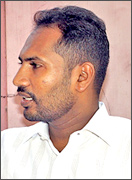
M.I. Ubaidur Rahman
MD, Jahi Weavers. |
Maruthamunai is a village situated 2.3 km away from the north of
Kalmunai at the 390 mile post in the administrative division of Kalmunai
Divisional Secretariat. It belongs to the Ampara District of the Eastern
Province.
Maruthamunai has been known for its family-based and factory-based
handloom weavers throughout the years. According to the report of the
Eastern Social Mobilizing Organization (ESMO), as a result of the
tsunami disaster of December 26, 2004, 366 families lost their 768
handlooms and their inputs.
|
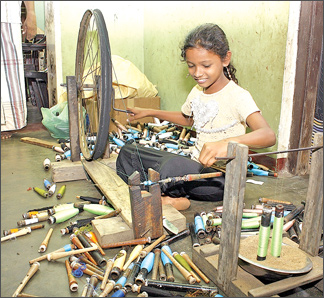
Done a lot of warps. Pictures: Mahinda Vithanachchi |
The Divisional Secretariat of Kalmunai estimated the loss of weaving
industry in Maruthamunai to Rs. 6.8 million. ESMO also reports that at
present there are 1,084 families in Maruthamunai, engaged in producing
handloom clothes.
What we see today is the degree in which the weaving industry has
clambered back to being a viable industry, five years after the
devastation of tsunami.
M.I. Ubaidur Rahman, Managing Director, Jahi Weavers, is one of about
ten weaving industrialists in Maruthamunai. He had lived in the UK and
returned to his village in 1999 at a time when most of his people had
given up weaving for not having a market for their products. The quality
of their products too had fallen. Some of the weavers were leaving
Maruthamunai to work in Kurunegala.
“My grandfather, U.L. Aliyar Lebbe, was the best weaver in
Maruthamunai,” Rahman told the Daily News in his home-based store of
hand-woven saris, sarongs, shirtings, shalwar materials, table cloths
and bed sheets, where a bevy of young women draped in abhaya, the
caftans, worn without the niquab, the face veil, was busy with sewing,
quality controlling, ironing, packing and looking after the finished
products. “When there were weddings, my grandfather was asked to weave
sarongs for them.. We have more than 100 years history of weaving.”
As he remembers, some of the weavers had obtained training in Jaffna.
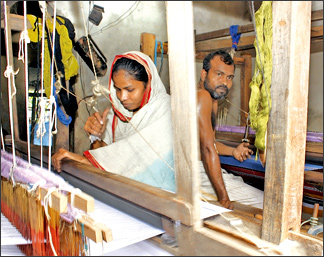
Uvais couple weaving at home. |

Rahman’s machine for dying several bundles at a time. Nazeem at
left |
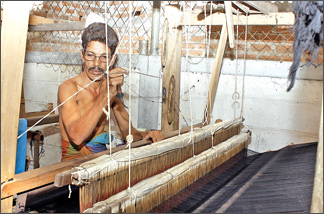
A male weaver at his loom |
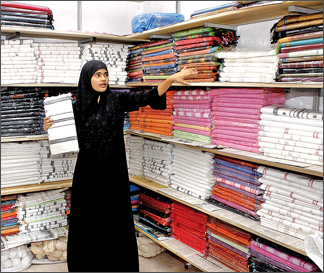 |
|
Selling saris at Rahman’s store. |
Rahman began a textile business in the village town but was not
satisfied as he craved to try his hand at creativity. “I asked my father
and grandfather for their ideas,” he said. “They had weaving mills and
had given up weaving but they had the experience.” Rahman was also
approached by a master weaver who was brimming with technical concepts.
Together, they were able to obtain some conceptual input from the
Industrial Development Board (IDB) in Kalmunai. “We asked them how to
start the weaving industry,” Rahman said. “I was thinking about our
community and how to improve the community on weaving.” Begin a public
corporation or a co-operative for the weaving community and we can help
you financially and technically, the IDB told Rahman.
Products
The Eastern Provincial Director of Industrial Development in
Trincomalee infused in Rahman the idea of starting a people’s company,
which he did, with more than 300 people who have a history in weaving,
pooling in small amounts of money. Turning out a few sample products,
they went to Colombo, to meet the Director of the Department of
Textiles, Vijitha Senevirathna.
“The Director was very happy,” said Rahman. “He said that he had been
in office for ten years but no one from Maruthamunai or anywhere came to
see him with their products.” The Director visited Maruthamunai and
inspected the envisaged weaving premises. Rahman was further helped by
his Member of Parliament Rauf Hakeem who arranged him to meet exporters
of hand woven products. The weavers comprised 95 per cent Muslims and
five per cent Tamils, Rahman said.
Beginning with five looms in 1999, the Maruthamunai weaving company
was able to increase the number of looms to 25 in 2001 and to 3,000 in
2004. Then the tsunami came and wiped away most of it. “About 500 people
died and more than 2,000 people gave up weaving,” said Rahman. “The
weavers didn’t have a proper place for the looms and some people left
for masonry jobs.” A saving hand appeared again in the guise of the
Director of the Department of Textiles. He said, “Don’t give up! Start
again!”
Rahman and his group revitalised weaving with ten looms in
Navidanweli Divisional Secretariat Division and wove sarongs, saris,
shirtings, table cloths, napkins, bed sheets and shalwar material. “The
designs we had when we started, were not in the market,” he said.
“Buyers did not want those designs.
From TV advertisements and modelling programs, we picked up ideas
about the colours and the kind of saris and sarongs that could sell in
the market. Now our products are moving very fast in Colombo and
Hameedias is the main buyer.” After the tsunami, visiting Maruthamunai
in order to help the weavers, Hameedias bought hand woven cloth and used
it in their costumes. Rahman said that Lanka Fabrics, No Limit and
Laksala also bought their products.
Wages to the weavers are paid at piece rate. Before tsunami, although
weaving a sarong cost Rs.20, in order to attract workers, Rahman paid Rs.
50 per sarong. Post-tsunami, it is Rs.150 per sarong. Wages are paid
every Thursday and Friday is the customary holiday in Maruthamunai.
Rahman had gone around inviting weavers to join him and he says, “Many
of them have still not come back to normal. All they can think of is the
property and the relatives they had lost in tsunami.”
Weavers
He had provided looms to their homes so that the young women too
could weave. Said Rahman, “There was a demand for sarongs. We also
received Daham School sari orders. Orders were more than we could
manage.”
With his good will and image, Rahman was able to obtain credit from
the EXPO centre and bought land for his industry. He gathered groups of
weavers and put up small cottages, placing in each, five looms and one
supervisor. Weavers could also weave at home and the work is collected.
“In one month, we made about 3,000 sarongs, 1,500 saris and other
material,” Rahman said. “Now customers come from Colombo, Kandy and
Ratnapura to buy our goods. With peace, we should have more customers.”
At present, Maruthamunai has about 100 of small cottage factories and
about 1,000 families involved in weaving. “They are earning more than
Rs.700 per day,” Rahman said.
Rahman’s people’s company also holds regular exhibitions at the
B.M.I.C.H. in Colombo, receiving stalls and transport free from the
Department of Textiles and linking with new suppliers. “In 2003, we had
the best exhibition in our lives. In three days, all our products were
sold and we had collected Rs. 25 lakhs. Shop owners and individual
buyers couldn’t believe that Sri Lankans could make products like that,”
Rahman said. Since the duty on Indian cloth has increased, Maruthamunai
cloth has a better chance, he says. Yarn for the looms is imported from
India by suppliers in Colombo at a 20 per cent discount.
The hierarchy of the weaving industry is from the weaver to the
supervisor and then to the master weaver. “Master weaver is the one with
all the ideas and he can do everything in the industry,” explained
Rahman who too, is a master weaver. “In our village, we have more than
20 master weavers.”
Good quality
Pointing out the dynamics of the weaving market, Rahman said that
although many of the weavers want to earn from the industry, they do not
know the market and are producing their own designs which cannot be
sold. “Weavers can ask the master weavers who know about the market and
demand.
But they don’t come to ask. We are losing these weavers because they
are fed up.” He also points out that there are sarongs which are sold at
Rs.450 but are of very poor quality. “The same sarong we can make of
good quality and sell at Rs.150. Those weavers are losing Rs.300 per
sarong.” Some do not know how to find the correct quality of yarn and
good quality and low quality yarn are sold at the same price.
Since both yarn and dye for the yarn is imported, the only local raw
material used is the salt mixed for certain colours. Rahman has his own
dye factory, to dye the yarn he uses.
The Daily News also met another master weaver, Ahmed Nazeem, whose
company in Maruthamunai is Ahamed Fabrics. “My father was weaving before
tsunami but the tsunami destroyed that,” he said. “I entered the
industry after the tsunami. My products are kuruthas, shirtings, sarongs
and saris.” His profits are good, he said, which are more than Rs.50,000
monthly. “There are 25 people working in individual homes for us and we
also have our own dyeing factory.”
Rizvia, a young woman who has been sewing in Rahman’s store for one
year, said that she stitched about 125 sarongs a month and earned around
Rs.18,000.
One cottage factory had a group of bare torsoed, sarong clad male
weavers, robustly pedalling at their looms. “In weaving, you need to
work your whole body, your eyes, your hands, your feet and your brain,”
explained Nazeem. “For one minute, you can work without a break. To
weave two meters for a sarong, it takes one-and-a-half-hours and six
meters for a sari, it takes one day.” He also demonstrated how the dyed
yarn is wrapped on shuttles which are hooked on to a loom to weave the
warp threads that are held in one direction on the loom. Next, in the
opposite direction, the weft threads are woven under and over the warp
threads.
In one home, Uvais and his wife wove full time while their eldest
daughter, 11-year old Sajana, a sixth grader, prepared food during her
school vacation. Sajana could also speak some English and helped her
parents by wrapping threads on to shuttles on the wheel and earned about
Rs.150 pocket money. The Uvais couple said that they have been weaving
for the last 16 years.
In weaving families, every member was linked to the industry in some
way, explained Nazeem, with children assisting their parents. Badurdeen,
a master weaver, has been weaving for five years and produced 1,500
sarongs a month from shot material.
The Daily News also visited a dyeing factory, the owner of which was
Subair. “What is imported from India is grey yarn,” he said. One bundle
of grey yarn equivalent to 4.54 kilos costs Rs.4,000. Grey yarn is
bleached and drenched in the dye bath in which dye had been dissolved in
water and warmed with fire underneath. The dyed bundles of yarn are
wrung by hand and left to dry, before they are wrapped on shuttles to
weave warp thread. The entire dyeing process is manual. “Maruthamunai
has about seven dye factories,” Subair said. “While we dye for our
weaving purposes, we also dye other people’s yarn for a payment. From
the latter, we have a profit about Rs.150 per one kilo of yarn.”
Safeera has been dyeing grey yarn for two years, helping her husband.
“In one day, about 25 bundles of yarn can be dyed, “ she said. Five
workers were employed in their factory, with earnings ranging about
Rs.800 - 1,500 per day. “During the school vacation before Ramazan
festival, children come to work for pocket money to buy new clothes for
the festival.”
Machine
While a dyer in a dyeing factory could only dye one bundle of yarn at
a time, Rahman, using his technical acumen and helped by his brother,
devised a manually operated bundle turning machine which can dye several
bundles at the same time. “We can dye 12 kilos of yarn at a time and 90
kilos in a day,” he said. “Normally, two workers are needed to work
together to dye.
But only one worker is needed for my machine. This way, the colour of
the dye is evenly spread onto the yarn and not shaded.”
While Maruthamunai can be seen as a traditional Muslim village, with
villagers been there for generations, Tamils also live there and the
weavers said that they have never fought with each other but lived
together peacefully side by side. Signs of tsunami were still not
completed erased and amidst destroyed houses, only wells remained
intact. Fishery and rice mills which indicate other main livelihood
pursuits in Kalmunai could be seen in the distance.
(We thank F Tech Engineering Services
Maruthamunai Project Manager M.S. Mohamed Fazeel who helped us obtain a
comfortable stay at Sea Breeze Restaurant and Guest Inn at
Sainthamaruthu, Kalmunai, and provided us with necessary contacts to do
our stories. We also thank P.M.M.A. Cader, Journalist, who also gave us
contacts and accompanied us in our rounds at Maruthamunai.) |



